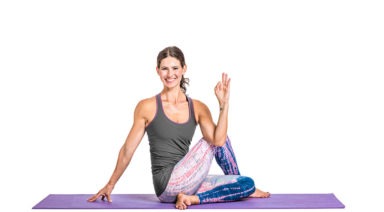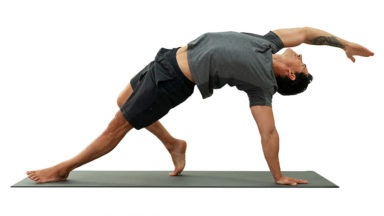How to Set Up Your Own At-Home Yoga Retreat

The weekend is finally here…but you’re stressed and tired from a grueling work week! Why not make the most of your weekend to rest and recharge in one of the most invigorating, centering ways possible? Yoga Journal had a great idea: treat yourself to a yoga retreat. The best part is, you don’t even need to go anywhere or pay anyone!
Your Own At-Home Yoga Retreat, Simplified:
Wipe Your Calendar:
If you can, you can allocate 3-4 days for the best effects of a bonafide yoga retreat. But for most of us, vacation time on a whim isn’t plausible, so a weekend will do if you make the most of it! Make sure you rearrange or cancel any commitments so you aren’t interrupted from your Zen at all; make it the same as if you were going on vacation, and make yourself unavailable to the outside world.
Practice Both AM & PM:
Now that your calendar is clear and your routine is reset, you have all day to do your favorite thing: practice yoga. Take advantage of it! You can either buy a class card or pass from a local studio, or you can easily practice at home to really capture the retreat ambiance. You can stream classes straight into your living room, or follow your usual, self-led practice. You’ll really start to feel the effects of a twice-a-day practice versus only once, or a handful of times during the week. It allows you the inner connection you usually get during a yoga session, only it takes you deeper. Kino MacGregor, founder of Miami Life Center, suggests, “If you have one really active practice in the morning, then you can be more meditative and introspective in the afternoon, working on alignment and therapeutics. It creates a holistic program.”
Find a Friend:
Looking to spend some extra quality time with a best friend? Need to make up your Valentine’s Day disaster to your significant other? This is the perfect time to bond for a weekend of health and wholeness. You get to spend time together getting set up for the retreat, grabbing snacks, drinks, and meals, and whatever yoga accessories you may want. And then you get to spend an entire weekend together, totally at peace and tuned away from any conflict.
Cut the Cords:
It’s time to imagine you’re on an island somewhere far, far away. Of course you don’t have cell reception or WiFi! Turn off your cellphone and stash your laptop somewhere where you won’t be tempted to grab it. This is the perfect weekend to try a tech detox, and you’ll be amazed at the mental results after you’re done! It even has some health benefits, according to Levi Felix, co-founder of The Digital Detox, “It lowers blood pressure, lowers heart rate, lowers cortisol, and helps us sleep better.” Perfect for a retreat.
Center Yourself:
When you’re not on the yoga mat, be sure to turn your gaze inward. You can get in some great meditation sessions in (even if you’re new to it!) when you’re not being bugged by the outside world 24/7! Be sure to journal what’s going on internally, as well. Now that you’ve unplugged, you have time to return to your favorite hobbies, as well, such as reading, writing, or drawing. Do whatever restores you.
Treat Yourself:
You’ve gone to the hard work of setting up this retreat, so make sure you enjoy it. Indulge in healthy treats that will help your yoga practice, like honey and whole Greek yogurt, fresh fruit, or your favorite (non-routine; this is vacation, remember?) smoothie. And what would a relaxation weekend be without a little spa action? Make your own, all-natural facials. Take a long bath with natural oils, candles, and tranquil music. If you have a friend over, trade massages (it’s okay if you only know how to do feet!). If you don’t mind leaving the house, you can always stop by the professional spas on the way home from your yoga class, as well.
Get Some Shut-Eye…Seriously:
As much as meditation can recharge you, there isn’t much better for refreshing and healing your body than a good night’s sleep. So tuck into bed early, but don’t be a bedbug. If you can manage it, try to rise and sleep with the sun to reset your circadian rhythm.
Yoga at Home: the Intimate Experience of Self-Practice

There are a lot of reasons to begin a home practice, but one of the most rewarding is the way a dedicated sadhana, or practice, can make anywhere you unroll your mat feel like home. And while nothing quite compares to the live transmission of a living, breathing teacher, there is an unparalleled intimacy that grows out of self-guided practice. Not to mention the opportunity to drop into a personal connection with the divine while eluding the modern obstacles of schedule, cost, convenience, availability, travel time, etc. But before we get into the details of how to practice yoga at home, let us consider for a moment what yoga is.
Yoga is not something you do, it is something you are.
With a more practical explanation, Leslie Kaminoff says any time your body, your breath and your mind are doing the same thing at the same time, you are in a state of yoga. Please don’t get me wrong, the clarity of this message need not take away from the infinite depth of what is a lifelong practice. However, yoga can be plainly understood as a state of union where all the fragmented parts of ourselves — physical, mental, emotional, spiritual — coalesce into a singular experience of the present moment. With that understanding, it is possible (and important) to feel the freedom of being yoga anywhere, especially at home.
When you can experience yoga at home, you have the potential to live your yoga every single day — whether you’re a seasoned practitioner with memberships to studios all over town or someone nurturing the initial seeds of curiosity. My humble intention here is to share what I’ve learned in my personal, sometimes messy, exploration of the art of home practice.





































